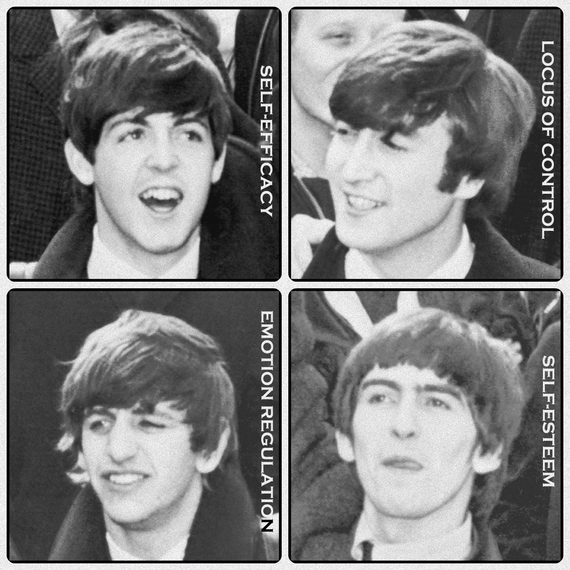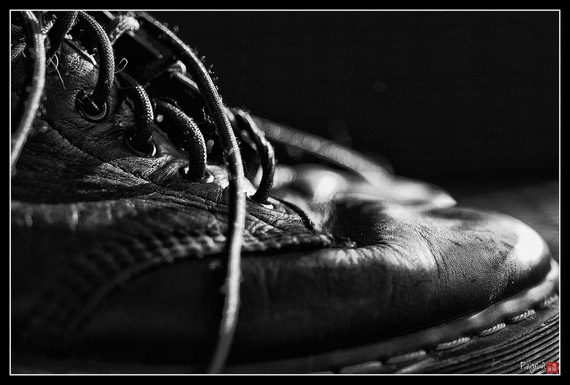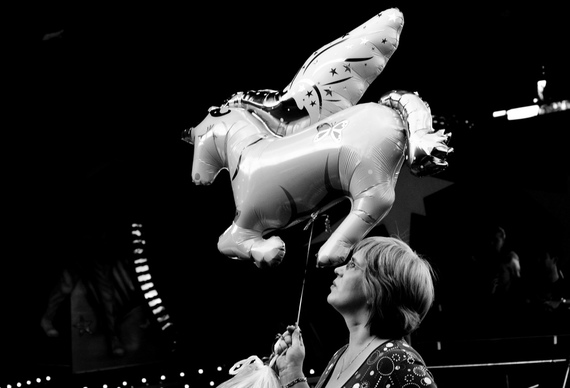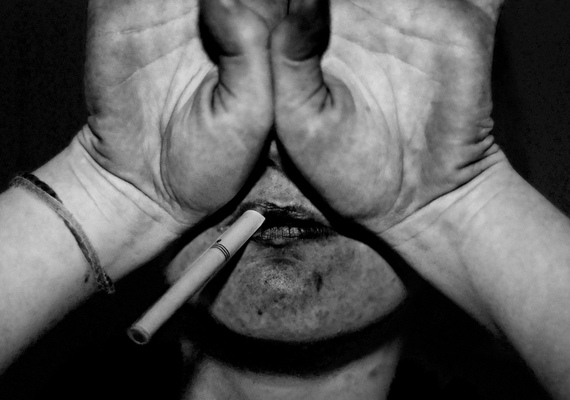Since Babylonian times, we've been paying our respects to Janus, the two-headed, past-perusing, future-swivelling god of doorways and bridges, borders and movement, time and transitions, receptivity, transformation, and change.
Self-initiated change that is, which lies at the heart of new year's resolutions. Where we vow year after year (in order of statistical priority) to lose weight, get organized, and increase our fitness levels. Where "Falling in Love" apparently ranks only ninth in this resolution hierarchy, perhaps indicative of mid-winter as opposed to a spring resolving mentality, or maybe just the arbitrary nature of the act itself.
"The New Year's Eve is more precious than a thousand pieces of gold," writes one of the great writers of the Japanese Edo period, Ihara Saikaku, in his linked collection of stories This Scheming World, published the year before his death in 1693. Saikaku's thousand pieces of gold aren't just a glinting metaphors piercing through the bleak mid-winter darkness, but rather they point to a pecuniary set of resolutions that every city dweller in his day had to discharge within the last 24 hours of the year.

During the Tokugawa period (1603 - 1867) buying and selling among Japanese merchants was carried out mainly on a credit basis. New Year's Eve marked the point where all these accumulated debits and credits of the previous year had to be balanced. To give you a flavour of the tumultuous score-settling hustle, here's Saikaku's scene-setting for his story "Holy Man Heitaro:"
"The calls of year-end bill collectors competed with the voices of beggars singing purifying charms in doorways on the last night of winter, and the sharp sounds of merchants tapping on their scales with mallets, weighing out the silver they owed, clashed with the clattering of dried beans thrown in every direction to ward off bad fortune as spring approached. There was something uncanny about it all, as if a demon had been tied up and was struggling to get loose somewhere out in the dark. People felt vaguely but distinctly nervous about what might happen."
Returning to the metaphorical realm of our end of year resolutions, that "vague but distinct" anxiety of 17th Japanese hoi polloi lingers. For us, it's a psychological balancing of the books that pulls us over the threshold of the old year and into the new, settling score with those inner debtors who find our activities of the last 12 months wanting, as well as dreaming of credits new. "Our hopes such as they are," writes the poet W.S. Merwin in To The New Year, "invisible before us/untouched and still possible."
And yet with these hopes, even though a slew of broadsheet and online articles tell us not to bother, don't we still feel the pull towards some sort of formal rite to solemnise the future transformations in our lives we wish to fulfill? Another poet, Kim Addonizio, more skeptical than Merwin, whilst taking her new year's day constitutional, vows to "resolve nothing," and yet even her poem ends with a kind of mindful resolution:
to walk
a little longer in the cold
blessing of the rain,
and lift my face to it.
Cicero, doffing his laurel wreath at Janus gives us a clue to why we never grow tired of year-end: "As in everything, the first and last have the greatest force." Think about the importance of first and last in job interviews, or any kind of audition-like social interaction. Psychologists refer to this as The Serial Position effect which also goes to explain why the first sentence below might convince you to resolve your way into the new year, whereas the second and third won't:
A) Resolutions are psychologically calibrating, aspirational, futile, but regulatory.
B) Resolutions are futile, psychologically calibrating, aspirational, and regulatory.
C) Resolutions are psychologically calibrating, aspirational, regulatory, but ultimately futile.
We need ways of marking beginnings and endings in our lives. We also actually enjoy these kinds of gestalts: denominating through some kind of written or spoken self-assertion, that one notion of ourselves, played out in a certain course of behavior, can be initiated or brought to an end. We do this so that we can make way for other existential options. Without resolutions, we'd be stuck not just with the inertia of Groundhog Days, but with Groundhog Selves too, Groundhog Lives: always responding to the same challenges with the self-same set of attitudes, along with that in-a-rut, sinking feeling of being unable to shift or change.
Why then, even with the most whizz-bang, double-blind, placebo controlled studies of cognitive behavioral strategies assisting us in our self-change plans, a veritable library of well-researched, and pretty wise popular and academic books on the topic, do we still find it so incredibly hard to put our resolutions into action?
There are a number of good reasons, but I'm going to focus on the main ones here. Psychologists call them Core Self-Evaluations (CSE), but I like referring to them as the Fab Four Foundations of Change: that would be Paul (Self-Efficacy), John (Locus of Control), Ringo (Emotional Regulation), and George (Self-Esteem).

Paul (Self-efficacy) is the extent to which we believe in our own capabilities, especially when it comes to influencing and galvanizing our motivation, thoughts, emotions, and behavior in order to achieve tasks that are meaningful to us. The jaunty bass stride of Self-Efficacy has a slightly different quality to the taking-centre-stage-for-a-solo stylings of Self Esteem (George). Self-Esteem reflects more our overall sense of worth and value as a person; Self-Efficacy is the means by which we feel ourselves up to the developmental task.
Locus of Control refers to the sense we have of our own agency. Generally we either fall into one of two categories: having an internal-focused sense of control, where we perceive our ability to make changes for ourselves and to our environment as self-directed, a sense of being, or at least feeling that we're in the driving seat. Alternatively, there's the external LOC position, where we would be more likely to see ourselves as passengers, constrained and contained by contingencies, heredity, lucky breaks, serendipity, and all the other haphazard gyrations of fortune's wheel.
Finally Ringo. The all important backbeat of Emotion Regulation, supplying us with ways of coping with negative or stressful life events. Not just death, divorce, illness, and work-woes (the major life-stressors), but also the drip-drip-drip feed of irritations and frustration: the boiler that breaks down over a long-weekend when all the plumbers are charging orthopaedic surgeon fees, slow-moving checkout queues, lack of sleep, noise, loneliness, exams, perfectionism, flat tyres, mice, and our various relationship conflicts.
(Before we go on, if you're wondering what kind of shape, your Core Self-Evaluations are in at the moment, here's a Fab Four MOT to help you with your assessments:
Emotion-Regulation MOT
Self-Efficacy MOT
Self-Esteem MOT
Locus of Control MOT)
Stripped to their archetypal contours, all resolutions are essentially one of two things: doing something LESS/MORE, and STARTING/STOPPING.
This might play out as wanting to do more exercise, or less snacking, more book-reading, less smartphone twiddling. But we also may ask ourselves to definitively stop or start an activity we either want to jettison or introduce into our lives, as in start an MBA, stop procrastinating, start meditating, stop using condoms (aka have a baby).
When put like this, without factoring in the impact of our Core Self-Evaluations, resolution goals seem eminently executable. So why do only one in ten resolution makers deem their efforts successful? This year I've gained an extra 1.5 stone, which I'd quite like to lose. Although I know by now the simple empirically-validated mantra for doing so ("eat less, exercise more") I hardly see this taking me back to last winter's trouser girth; the practical answer coupled to the desire for transformation, doesn't necessarily result in a solution.
And that's just in the realm of calorie counting, what about the existential subsoil in which the winding down of the year takes us into? Jimmy Santiago Baca begins his new year poem admitting that "It would be neat if with the New Year I could leave my loneliness behind with the old year. My leathery loneliness, an old pair of work boots my dog vigorously head-shakes back and forth in its jaws, chews on for hours every day in my front yard - rain, sun, snow, or wind..."

Photo by Paige
If you're feeling lonely, you probably already know that you need to stay in and mope less, get out and socialise more. But will you? Not if your self-esteem and self-efficacy levels are low: your mind telling you that the kind of people you might want to hang out with would have no time for the likes of you; your external locus of control waiting for outside forces to intervene ("If I see something interesting on my Facebook notifications, I'll push myself out"). Or maybe choppy emotion regulation strategies putting you under sway of the smallest mood-swing: "I'm not feeling up to engaging with people at the moment, bettter to stay home". Maybe like Baca, you're able to have the insight that "my happiness depends so much on wearing those boots": our afflictive comfort in enduring, self-defeating characteristics. Wobbly at the best of times, even the most determinative resolution, if unsupported by a healthy Fab Four, will quickly get trampled over by those old boots. Our resolutions in other words are only really as resilient as the Fab Four fortitude of our inner self evaluators.
If this is so, then it stands to reason that we don't need better, sharper, more targeted new year's goals, or resolutions, or even different ways of achieving them, but rather strategies to help us beef up John, Paul, George, and Ringo.
Almost 100 years ago, Freud unfussily and even colloquially parcelled the resources of his Fab Four notions into the term "das Ich" (the I), which his English translator Lytton Strachey then latinised into the word "ego". Freud's Ich functioned in the psyche as a kind of resourceful equestrian (his horse being the wayward nag of dysfunctional, mainly unconscious passions and appetites of the Id - "das Ech" in Freud's German, literally It).
Freud must have borrowed the analogy from Plato, who in Phaedrus divides the soul into three: two opposing horses and a charioteer. The one horse has "a lofty neck and aquiline nose", only perhaps needing the slightest nudge of a knee to display behaviours of "honour, modesty, and temperance", that part of us that buys copies of The Big Issue chews and sparingly savours mouthfuls of silver-service forked food when dining at the in-laws. The other horse is short and thick of neck, crooked, lumbering "the mate of insolence and pride, shag-eared and deaf, hardly yielding to whip and spur". That horse is the Eeyoreish mule that pokes its head into the lounge on January 3, or 13th or even 30th demanding to be fed mince pies and port, and sod the Open University essay you're meant to be doing some reading for, what's on iPlayer?

Photo by Raul Lieberwirth
One of the key tasks of psychotherapy ever since its inception, has been to build and bolster the charioteer, the psychodynamic notion of ego strength, that flexibile, creative, and balanced Fab Four, our Ichs. My primary resource for doing this is Schema Therapy, a combination of psychodynamic and psychoanalytic insight as well as cognitive-behavioural tools designed to train the I-rider into manoeuvring different limbs of our personalities in a kind of self-enforcing dressage: so as to emphasise rhythm and flow, impulsion, and a kind of psychological suppleness in line with our deepest needs and values.
The Fab Four depleters, what schema therapists call our maladaptive schema, can be seen as chinks in that process; a number of confounding Achilles' heels (there are 18 potential schemas) triggered by situations, thoughts, events, maybe even a song or smell that render us confused, distressed, or just dopey. Sown in childhood, often as a response to unmet needs, they amplify and augment as we age. By the time we reach adulthood, they most likely feel like intrinsic aspects of our personality: deep-rooted beliefs and ideas about ourselves and others which seem almost unchallengable; strong self-defeating notions bleeding into our very Core Self-Evaluations. They out themselves as behavioural dispositions (an inability to commit to goals, to change in the ways we'd like to change) particularly when making these changes bring up challenges for us.
Another way of thinking about schemas are as lifetraps: painful ways of being and acting which we feel ourselves to locked into, unable to alter, even whilst recognising how they might hold us back. Say you have a Defectiveness or Failure Schema generating a little a downbeat soundtrack for your every move (Jeane by the Smiths, segueing into Born To Lose by Ray Charles), a hashtag fail dogging every resolution, how likely are you, or anyone, to succeed with what might actually be a pretty good new year plan?
 Photo by Cory Kirby
Photo by Cory Kirby"I need help with long term hope, I need help with the dawn of war and achieving my new year's resolutions," writes Alli Warren, who also says she needs some assistance with "moving her chickens", her dog who "keeps marking the wrong areas", as well as her breasts ("a distance problem involving constant acceleration and tethering glitches"). For all the wry, self-deflecting humour, the title of her poem points to a kind of privation that we all experience at times: The Help I Need Is Not Available Here
Maybe this is the panicky thought taking us to the very edge of our Fab Four powers, right up to that anxiety-provoking schema-bottlenecked point, where everything seems to fizzles and fold. It's at this edge where we most need help to address these impediments. We don't, and really shouldn't have to keep our Fab Four in adequate shape alone.
So get help if you need it. But heed not the resolution naysayer, I say(er). Our resolutions bring us into a relationship with our inner collisions and contentions. You could say, as W.S. Merwin says in his poem To the New Year, that they are:
...the sound of you
here and now whether you or not
anyone hears it this is
where we have come with our age
our knowledge such as it is
and our hopes such as they are
invisible before us.
Cherish them.
--
Steve Wasserman is a psychotherapist in private practice working with both individuals and couples.
He also runs bibliotherapy and Poems-By-Heart courses and is very much interested in the therapeutic applications of walking, writing, reading, gardening, learning poetry by heart and every other practice that bring us into "flow".
No comments:
Post a Comment